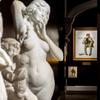The Story Behind Gatti’s The Master Light of All Our Seeing
- March 26, 2020 13:01
Within the Turnbull family plot in Baltimore beneath a sunburst headstone, Sidney Lanier has his final resting place. Who was this man, and how did he come to be buried with the Turnbulls? Perhaps the more interesting question is, how did he come to be featured in Annibale Gatti’s masterpiece, The Master Light of All Our Seeing?
Some of the greatest works of art are surrounded by an air of mystery, and almost all of them have an interesting story to tell. When we first acquired this significant work, its story was still a mystery to us. One of the pleasures in dealing in fine art is going down the research rabbit hole and discovering an artwork's history for ourselves. The Master Light of All Our Seeing took us on a particularly interesting research journey, allowing us to answer the questions “Where did it come from?” and “What does it all mean?”
In order to answer those questions, we first had to become better acquainted with Sidney Lanier. In every sense of the word, Lanier was a true Renaissance man. A highly celebrated poet, he also served as a soldier during the Civil War, and shortly thereafter briefly worked as a lawyer. He was named first flautist of the Peabody Orchestra in Baltimore, and later became a professor of literary theory at Johns Hopkins University.
Even if you don’t know his personal history, you have almost certainly heard his name. Two lakes are named for him, one in Georgia and one in South Carolina. A statue of him stands alongside Thomas Jefferson at Duke University, and a memorial plaque at Johns Hopkins University commemorates his accomplishments. An amazing fifteen different schools bear his name, and even an entire county in the state of Georgia.
He was also great friends with the Turnbull family, which brings us back to his grave. Thanks to his remarkable talent as a poet, he came into contact with Frances Turnbull, the founding president of the Woman’s Literary Club of Baltimore. Frances was undoubtedly his champion and confidante, and she soon came to consider Lanier and his wife family — so much so that Lanier was buried in the Turnbull family plot. Frances is the one who commissioned this oil on canvas from Gatti, requesting that her dear friend be depicted alongside all of history’s greatest artistic minds.
Lanier is shown standing in conversation with Robert Browning, while around them are the great writers including Poe, Whitman, Shakespeare and Homer. Composers including Bach, Mozart and Beethoven are all included, as well as artists including Raphael, da Vinci and Michelangelo. In total, over 40 historic figures make up this fascinating work.
In both composition and subject matter, the work is evocative of Raphael Sanzio's legendary fresco The School of Athens. Both symbolize the interconnectedness of the arts and philosophy, bringing together the great minds of both history and their respective ages. Yet, Gatti takes the idea one step further, also representing the geniuses of the future in the children figures at the center of the canvas. Furthermore, the figure of Jesus can be considered the central subject of this work, symbolically positioned as the “Master of All Our Seeing” as his light shines on the multitude of figures who surround him.
Though The Master Light of All Our Seeing was commissioned as a celebration of Lanier’s memory, he doesn’t stand above the rest of the figures in the scene. The equal standing of all these men and women recalls the words of Sir Isaac Newton: “If I see further than others, it is because I stand on the shoulders of giants.” The giants in this painting are the geniuses that the Western world have recognized as the pillars of our artistic knowledge.
Perhaps it is coincidental, or perhaps a matter of genius artistic continuity, that the same sunburst that graces Lanier’s headstone is also carved at the apex of this painting’s original frame. As both a masterpiece of its genre and a celebration of humankind’s artistic achievements, it is one of the finest paintings that M.S. Rau has encountered in recent memory.
About M.S. Rau:
M.S. Rau has spent more than 100 years earning the trust of discerning collectors worldwide. Located in the heart of New Orleans’ historic French Quarter, our peerless showroom houses one of the world’s most extensive and stunning collections of museum-quality fine art by artists such as Claude Monet and William Bouguereau, 18th- and 19th-century antiques and breathtaking jewelry, including rare colored diamonds.






100x100_n.jpg)

100x100_c.jpg)









100x100_c.jpg)


